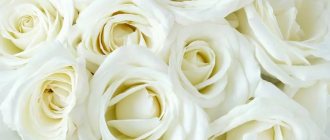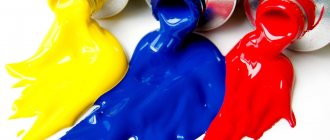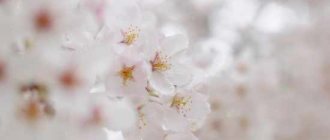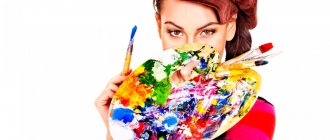Rainbow psychology
As children, we all rejoiced at the appearance of a rainbow in the sky after the rain. Everyone tried to memorize the number and sequence of colors of the rainbow. Who among us does not remember such funny phrases as:
- Every
Hunter
Wants
to
Know
Where
the
Pheasant
Goes . _ _ _ _ - How
once
Jak
- Zanar
Head
broke
the
Lantern
. _ _
_ _ - And other options.
Where the first letters of the words mean the corresponding color name:
- Each
one is red; - O
hunter - orange; - Wants
- yellow; - Know
- green; - Gde
- blue; - S
goes - blue; - Azan
- purple.
But we didn’t even think at that time that each color influences us, our character and our life to one degree or another. And now, having already become adults, we can trace the psychological connection of a certain color we prefer with one or another trait of our character.
Aster in the language of flowers
At first glance, it may seem that the aster is an unremarkable flower, but this is not so, because translated from Greek it means “stars” and the inflorescence of an aster, especially a needle-shaped one, looks like a celestial star. These star flowers are widespread in Europe and beyond.
There is a legend that speaks of Jupiter, who was angry with people and sent a flood to the earth, but the goddess Astraea was very sorry for the people, she cried bitterly and her tears falling to the ground turned into unusual flowers, which were later called asters. Therefore, sometimes asters mean sadness and sadness.
There are other legends about asters, they are no less interesting. For example, that an aster grew from a small particle that fell to earth from a star. In Greece, asters were considered magical flowers that could drive away misfortunes, hardships, and misfortunes from the home.
Another meaning of the aster is security. In the language of flowers in the modern world, asters and their meaning have changed and mean patience, the desire to change certain events, or to show admiration.
Asters can be given to young girls and women as a compliment, or to apologize for something, to ask for forgiveness. Asters are like stars, give them to your loved ones as an amulet for good luck, as a gift from the gods, as a piece of a star, unattainable but beautiful.
Red color in psychology
Since ancient times, people have shown a special interest in the color red.
In many languages, the same word means the color red and, in general, everything beautiful and beautiful. Among the Polynesians, the word "red" is synonymous with the word "beloved." In China, a sincere, frank person is said to have a “red heart,” while the heart of a bad, treacherous person is black. Red is exciting, hot, activating, associated with danger and aggression. Reds can easily attract attention to any advertisement. Your pulse and blood pressure may increase if you look at red for too long. Red tires quickly.
The meaning of red in psychology
People who prefer red love to be leaders.
Almost all their senses are at their maximum. They are persistent and do not like to put things off. It often happens that those who prefer red are demonstrative and selfish, intolerant, stubborn and cruel. A woman in red is most often inclined to flirt with guys. The color red also denotes power and greatness. In Byzantium, only the empress had the right to wear red boots. The emperor signed in purple ink and sat on a purple throne. For many peoples, the color red symbolizes the south, flame and heat.
Aggressive colors - red, red-orange.
Peony meaning
Peonies are beautiful and delicate flowers with a surprisingly pleasant smell and have their own special meaning in the language of flowers, not just one, but even several. There were legends about peonies in ancient Greece, where it was considered a symbol of longevity and healing.
In China, these flowers are especially valued. Peonies in the land of the rising sun are considered the imperial flower; it symbolizes wealth, nobility and prosperity, it is revered and idolized. In addition, peonies personify fiery love and are presented to loved ones.
Peonies are also a symbol of spring, rebirth, and the awakening of emotionality. White peony means chastity and modesty; such flowers can be given to young girls and brides on their wedding day. Pink peonies – romantic tenderness, caring and love. Red and burgundy peonies are considered a symbol of prosperity, respect and power.
Pink color in psychology
Pink is a soft color that dulls the emotions of anger and aggression.
In places where children with antisocial behavior are corrected, pink walls or furniture are often used. If after a hard day you come home angry and aggressive, look at something pink and your aggression will disappear. Pink can mean goodness, passion, romance, love. Those who prefer pink want to live life to the fullest, desire new experiences, are hardworking and do not like to rest. But sometimes people who prefer pink can be frivolous, childish, and love to show off in front of everyone.
The meaning of pink in psychology
Pink is the color of life, of all living things. He talks about the need to love and be kinder. Those who like him can become agitated over the most insignificant things. For people who are overly pragmatic, this color causes irritation.
What does the color of roses mean?
- Red roses have always been and will be a constant symbol of love.
- Burgundy roses , like scarlet ones, mean a passionate feeling of falling in love.
- Pink roses are a symbol of elegance and sophistication.
You can express your gratitude by presenting roses of bright pink or cherry color as a gift. At the same time, you can express your feelings of sympathy by giving soft pink flowers of unopened roses.
- Yellow roses mean care.
- Cream roses are a manifestation of modesty, friendly feelings, and gratitude.
- Green roses – abundance and generosity. You can't express love with green roses, but they can talk about jealousy.
- Black roses - as it happens in history, are an emblem of sadness and a symbol of death.
- Blue roses (light blue) are given to mysterious and inaccessible people.
All light roses can be given to each other without any special subtext, because they are a symbol of friendship.
Orange color in psychology
If you're in a bad mood, look for something orange.
Orange will certainly lift your mood, especially if it's winter outside. In winter, everyone enjoys orange even more than in summer, due to the lack of sun. It’s hard to imagine effective advertising without orange.
The meaning of orange in psychology
People who prefer orange are creative individuals.
They are strong, freedom-loving, and forgive everyone. They have inexhaustible energy that needs to be released, for example, by creating another masterpiece. Orange lovers may have a high opinion of themselves. Orange is the favorite color of intuitive people and passionate dreamers. In heraldry, this color also means hypocrisy and pretense.
Yellow color in psychology
Yellow is the color of gold, which since ancient times has been perceived as a frozen solar color.
This is the color of autumn, the color of ripe ears and fading leaves, but also the color of illness, death, the other world. Among many nations, women preferred yellow clothes. Often the color yellow served as a distinctive feature of noble persons and upper classes. For example, Mongolian lamas wear yellow clothes with a red belt.
On the other hand, among some Asian peoples, yellow is the color of mourning, grief, and sadness. In Europe, a yellow or yellow-black flag meant quarantine, and a yellow cross meant plague. Among the Slavic peoples, yellow is considered the color of jealousy and betrayal, and in Tibet jealousy is literally called “yellow eye.” Let us also remember the “yellow press” and the “yellow house”
The meaning of yellow in psychology
Yellow stimulates the brain and nervous system.
Yellow is joy, warmth and faith in the best. The combination of black letters on a yellow background is the most advantageous for the most effective advertising, as it contributes to better memorization of the text. But don't overdo it with yellow, as it can overstimulate the brain and cause anxiety. People who love the color yellow want to reveal themselves, to achieve the goal they have set for themselves. They are self-confident, joyful and cheerful. These people often have a high level of creativity. Yellow helps them in difficult times and concentrates their attention. Sometimes they like to gossip, or just chat, and are also often absent-minded and critical of themselves and others, but at the same time their self-esteem is not at all low, but on the contrary.
What does brown mean?
Brown +
Reliability, prudence, common sense.
Brown -
Depression, disappointment.
Brown is a darkened red color, while the impulsiveness of red in brown fades away, giving way to calm and stability. Those who choose this color stand firmly on their feet, respect traditions and internally crave peace - physical and mental. Rejection of the color brown indicates a neglectful attitude towards one's health.
The color brown expresses constancy, devotion and stability; Wearing brown clothes will increase your chances of passing an interview and getting a job. Under the influence of brown, anxious thoughts recede into the background. Usually the need for brown arises when physical and emotional fatigue reaches its extreme point. Brown is rejected when they want to emphasize their individuality, ceasing to depend on the instincts of the body.
Shades of brown
Yellow-brown
Yellow-brown symbolizes rigor and efficiency.
Cream
Cream charges you with optimism and faith in the best, making it easier to accept objective reality.
Green color in psychology
Green is a natural, calming and relaxing color.
Green has healing properties and normalizes high blood pressure. People who choose green choose their life path clearly and rationally. They approach any task in life with all seriousness. They love to help others. Their inner world is rich, but they are in no hurry to open it, even though they themselves are not secretive.
The meaning of green in psychology
Green is the color of grass and leaves.
For many peoples, it symbolizes youth, hope, fun, although sometimes it also symbolizes immaturity and lack of perfection. Green color is extremely material and has a calming effect, but it can also produce a depressing impression (it is no coincidence that melancholy is called “green”, and the person himself “turns green” with anger). The people of Iran associate the color green both with rapid growth and freshness, and with misfortune, sadness, sorrow, which is why they say “green leg” about an ill-fated person, and “green house” about a cemetery. In medieval Europe, jesters wore green and yellow clothes, and bankrupts in Germany had to wear green hats.
Our summer is winter, only painted green. Heinrich Heine
How to make a bouquet correctly
The holiday season is approaching, when it is customary to give bouquets of flowers. To express your attitude towards a person or tell him about love, it is important to know the language of flowers. It's not easy at all. It is different in different countries.
- For example, lilies among the Ancient Romans were a sign of splendor and wealth; they can be seen on ancient coins.
- The Egyptians placed lilies around the body of a dead girl.
- In Germany there is a belief that such a flower grows only on the graves of suicides and those who died at the hands of murderers.
- In France, lilies are depicted on the old coat of arms. If they give you this beauty, it means they show their respect.
We will not rely on signs in European countries, we will find out what bouquets the Slavs make up.
The snow-white lily is a symbol of innocence, girlhood, generosity, nobility.
A yellow lily symbolizes gratitude, but at the same time – extravagance, frivolity, capriciousness, even lies. When presenting a lily, keep in mind the meaning of the color.
Blue color in psychology
For many peoples, the color blue symbolizes heaven and eternity.
It can also symbolize kindness, fidelity, constancy, favor, and in heraldry it denotes chastity, honesty, good reputation and fidelity. "Blue blood" speaks of noble birth; The English call a true Protestant a “blue.” In addition, the color blue is close to black and receives similar symbolic meanings. It was considered mourning in Ancient Egypt and among some peoples of South Africa. The French call horror “blue fear” (remember the fairy tale about “blue beard”. Among the Slavic peoples, blue served as the color of sadness, grief, and was associated with the demonic world. Ancient legends describe black and blue demons.
Even or odd - the eternal question
The best gift for any celebration is flowers. Women especially love this gift. But when receiving a bouquet of delicate lilies or fragrant roses, they immediately pay attention to whether there is an even number or an odd number of flowers in the composition.
It is believed that an even number will bring misfortune or illness to the family, since this number of flowers is brought to a funeral or placed on a grave.
But such a rule has been established only in Russia and the CIS countries. Georgia and Germany like even numbers. A Georgian or German in love will give his beloved woman a composition of eight buds.
Russia adopted such a superstition from the pagans. They associated even numbers with the end of life's journey.
But an odd number, on the contrary, was considered forward movement. The pagans treated the number 2 especially poorly. Even those families where twins were born were considered cursed. It was also forbidden to light two candles in temples. It was believed that one candle was for the deceased, the second was his guide to the other world.
The following numbers are considered mourning: 2,4,6 and 8. And in European countries, wedding bouquets are made up of 6, 10, 12 copies. For married people, such a gift should bring family happiness.
If you were accidentally handed a composition of an even number, then place one flower in another vase, but not in the bedroom. The best place for a bad gift is the kitchen.
Blue color in psychology
If you want to inspire confidence in someone, wear blue clothes.
Blue will not only inspire confidence, but also respect for your person, and will also emphasize your high social status and show others that you are prone to stability. Water and ice blue soothes and cools. Heart rate becomes lower. If you want to motivate your employees to work efficiently, paint your office walls blue. This will help not only office staff to work productively, but also weightlifters to exercise more effectively. It has been proven that in rooms with blue walls, athletes' performance increases.
Purple color in psychology
Purple is a dangerous color.
It puts pressure on the psyche and causes apathy. At the same time, purple color increases low self-esteem. People who love the color purple are unusual - not like everyone else. It is difficult for them to realize themselves in life, they are usually very self-critical, and always control themselves very rationally.
The meaning of purple in psychology
The color violet also symbolizes the inherent infantility and suggestibility of a person, the need for support and support. In this sense, the choice or denial of the color purple acts as a kind of indicator of mental and sexual maturity.
Features of composing compositions
When arranging a flower ensemble, the florist will definitely ask you who you are going to give the bouquet to and for what reason. Of course, it is important to take into account the preferences of the person close to you, but in case of difficulty you should always contact a specialist. He will take into account the age of the recipient, his taste, and the importance of the event.
- For young girls. It is customary to give small round-shaped compositions to young ladies. Of the “solid” flowers, lilies and orchids fit perfectly into such bouquets. If you want to give roses, prefer light shades. A bouquet of peonies is appropriate to give to a young wife or future bride.
- For older women. In this case, it is worth taking a closer look at massive compositions that will include dark roses or large chrysanthemums. The shape of the bouquet does not play a special role here. The main thing is that the flowers are bright and the bouquets do not look cheap.
- For men . If you are going for a gift for a representative of the stronger half of humanity, choose discreetly elegant bouquets. In this case, flowers must be selected especially carefully. It is better to give preference to irises, gladioli, carnations or gerberas.
Lilac color in psychology
What does the color lilac mean in human psychology?
Lilac color is one of the shades of purple, as well as a mixture of blue and red colors (a mixture of feminine and masculine principles), means a bright future. Blue in this shade gives a certain chill, which also gives the meaning of nostalgia, and red - creativity.
Therefore, if we speak succinctly about the color lilac, then it means a clear future, nostalgia and creativity. This description is often found in teenagers who are full of energy, but at times experience depression, and they also have a long way to go.
The meaning of lilac color in psychology
Also, as the results of various studies have shown, the color lilac improves a person’s self-esteem.
Therefore, people with a low indicator are recommended to wear lilac tones or jewelry. The color lilac in human psychology is vanity and immaturity. This color is often chosen during adolescence.
Lilac color in the psychology of women
If the lilac color is loved by the female gender, this means that she has a creative inclination or the ability to fantasize and imagine well.
It is also generally accepted that such girls like to cheat themselves, while experiencing severe stress and depression. On the other hand, such representatives of the fair sex are cautious and have a desire for harmony and aesthetics. Usually, a love of color leads to a matching color wardrobe. But it is worth remembering that everything is good in moderation, you should not overdo it, since an excess of this shade can cause disgust from the people around you.
What does gray mean?
Gray +
- Realism, pragmatism, common sense, awareness; connects opposites.
Grey -
- Melancholy, desire to merge with the environment, lack of initiative, sadness, melancholy.
Combining the seemingly incompatible properties of black and white, gray feels alien and cut off from the world. He will never become the first because he does not internally strive for it. Calmness and harmony are the true values of gray. Living on the border between darkness and light, gray is lonely, exhausted and broken. For people who gravitate toward gray, emotions are something inappropriate and not decisive. Restraint exhausts and destroys them from the inside. Harmonizing everything around, gray feels uncomfortable. Someone who wears gray may suffer from old age and lack of prospects, or, conversely, believe in the best, but do not achieve these improvements through action. If there is a lot of gray in a person’s clothes, he is in search of feelings and sensations that would give him rest and inner harmony. At the same time, weak and vulnerable individuals draw strength from this color.
Shades of Gray
Light gray
Light gray speaks of readiness for new acquaintances, symbolizes inner freedom, and pacifies the mind and body. Light gray color expresses the desire for white.
Dark grey
This is a calm and heavy color. He has no inner strength. He talks about the struggle of common sense with unreasonable worries. Those who prefer it suffer from increased sensitivity and need satisfaction, both physical and mental, and are not looking for long-term serious relationships.
Trendy-U recommends: Appearance color type: how to determine?
Interview with a psychologist: Image creates mood
Black color in psychology
Black color in psychology, as a rule, symbolizes misfortune, grief, mourning, and death.
Thus, in ancient Mexico, during the ritual sacrifice of a person, the face and hands of the priests were painted black. Black eyes are still considered dangerous and envious. Ominous characters are always dressed in black, whose appearance portends death. Black color is authoritarian.
If we see a man or woman in black, or a black car, then subconsciously they become more significant for us. This is probably why the limousines of rich and wealthy gentlemen who want to appear authoritarian are black, like their clothes. The color black denotes not only authority and weightiness, but also aggressiveness. There is such an interesting fact: football referees more often punish the team that has a black uniform with penalties, as well as yellow and red cards.
People who prefer black are mysteries. They want to unconsciously attract the attention of others, since black is a curious color because it hides something interesting and scary behind it. If you wear only black, then this may indicate that you are missing something essential in your life. Thus, you protect yourself from unpleasant reality and try to hide. It's better to get out of this state. But this must be done slowly, gradually changing the attributes of black clothing to other bright colors.
The meaning of black color in psychology
It is believed that there is a connection between the color black and sexual attractiveness.
Among some African tribes, women with very black skin are highly valued as lovers, but not as wives. Love passion is shrouded in darkness and mystery; therefore, black can symbolize something intimate and passionately desired. Among the Arabs, the expression “blackness of the eyes” means beloved, “blackness of the heart” means love. Thus, black can also have a favorable meaning. It is perceived this way, for example, in the arid regions of Africa, where there is little water and black clouds promise fertility and abundance. Black bulls, goats or birds are sacrificed to the guardian spirits who send rain, and the priests also dress in black.
Gray color in psychology
In psychology, gray is a neutral color. It's rare to meet someone who loves gray, and just as rare to meet someone who can't stand gray. Gray does not distract from important matters, which is why business people prefer it. At the same time, gray is quite friendly and reliable.
The meaning of gray in psychology
Usually those who prefer gray put reason first, not emotions. Gray clothing gives strength to insecure individuals.
Is it possible to give hibiscus as a gift?
Chinese rose, or hibiscus, is a very beautiful and delicate flower. But for some reason the name was attached to it - “flower of death”. Superstitious people generally attribute incredible mystical properties to it.
Some signs about hibiscus have nothing to do with death; on the contrary, they foreshadow favorable turns of fate.
According to popular belief, if a rose blooms, someone will soon die. But this interpretation is associated only with some cases that people remember.
Trouble and disease are caused by wilting and shedding of leaves. If you notice this behavior of the plant, then pay attention to your health. Perhaps the disease develops somewhere inside.
And non-superstitious gardeners will simply feed the plant so that it does not draw energy from the people living here. Indeed, it has been noticed that if the plant withers, the apartment residents feel weak and unwell.
But there is another explanation. The Chinese rose collected all the negativity in the house, then began to wither, diverting some kind of misfortune from the owners, which they had no idea about.
White color in psychology
White color in psychology symbolizes purity, spotlessness, innocence, loyalty, virtue, joy.
It is associated with daylight, as well as with the productive force, which is embodied in milk and eggs. Associated with whiteness is the idea of the obvious, the conventional, the legitimate, the true. All hospital workers wear white coats, most likely because the color white has an association with cleanliness. White color in psychology symbolizes completeness and perfection, freedom of opportunity and the removal of any barriers. This color also symbolizes purity in religion. In addition to all this, white is a symbol of equality, because it is in it that all colors are combined.
The meaning of white color in psychology
People who prefer white are ready to devote themselves completely to their work, but at the same time they can be hard to touch.
Sometimes they can isolate themselves from everyone around them and the surrounding affairs, become disappointed in everything, and become detached and bored all day long. Sometimes they are open to the whole world, they can easily sense a lie, and just as easily reveal the truth of a complex problem. However, white can also have the opposite meaning. By its nature, it seems to absorb, neutralize all other colors and correlates with emptiness, incorporeality, icy silence and, ultimately, with death. The Slavs dressed the dead in white clothes and covered them with a white shroud.
It is customary among some tribes in Africa and Australia to paint the body with white paint after the death of someone close to them. In China and some other countries in Asia and Africa, white is the color of mourning. In the old days, white mourning was also used by the Slavs.
Explaining to someone why the condom was white, Ranevskaya said: “Because white makes you look fat.” Faina Georgievna Ranevskaya
Psychology of color and human character: relationships
Each person gives preference to one color, at least no more than two or three (depending on where these colors are used - in clothing, furnishings, car color, etc.).
The pleasant or unpleasant feeling that a particular color evokes can change over time. But in any case, the color you prefer can tell a lot about your character and emotional makeup. Psychologists in such cases use a color test developed by Swiss psychologist Max Lüscher in the late 1940s. The Luscher test, used by professional psychologists, requires special training for its use. The “lighter” version of the Luscher test can be easily tested by anyone, using the usual settings of a modern color TV. Psychologists say: if the color red predominates, then the owner of the TV is trusting, but overly emotional and aggressive. If yellow stands out clearly, then such a person inspires confidence in others, is an optimist and expresses friendliness. But the constant smile on his face is most often a mask behind which hides strong internal tension. The predominant blue-green color indicates that the person is timid and weak, but dangerous if someone gets in his way. And finally, those who prefer light blue are accommodating, lazy and do not know moderation in food and drink.
An experienced observer may also be able to provide additional information about a person by their preferred color of car. As proof of this, we can cite data from the American psychologist Berthold Schwartz, who claims that the color of a car can be used to judge some of the psychological characteristics of its owner. Thus, the owners of red and yellow cars are optimists, lovers of life and consider themselves happy. Green ones are worn by nature lovers and realists. Blue is chosen by people with a balanced character. Owners of white cars adhere to conservative views, while business people drive black ones. Gray and silver ones are to the taste of proud people, and brown ones are preferred by respectable spouses and fathers of large families.
What flowers are suitable for loved ones, acquaintances and colleagues?
- Flowers for a girl: lily of the valley, lavender, orchid, red rose.
- Flowers for the wife: gerbera, bluebell, pelargonium, red rose, aster.
- Flowers for a friend: iris, chrysanthemum, chamomile.
- Flowers for mom: carnation, marigold, tulip, sunflower.
- Flowers for my sister: alstroemeria, adonis, daisies.
- Flowers for grandma: yellow tulip, white rose, violet.
- Flowers for mother-in-law: lotus, yellow rose, epigea, olive.
- Flowers for a colleague: clover, white jasmine, Grand Prix rose, ranunculus, magnolia.
Article on the topicGuide for men: how to save on gifts for March 8
The meaning of colors in psychology - table
Below is a brief description and meaning of primary colors in personality psychology. Based on the preference for one color or another, everyone can independently draw a conclusion about their psychological characteristics. Table 1 - The meaning of colors in psychology (briefly)
| Color | Color meaning |
| Red | The color of passions. If this is your favorite color, then such a person is brave, he is a strong-willed, domineering type, quick-tempered and sociable. Moreover, he is an altruist. People who are irritated by this color have an inferiority complex, fear of quarrels, a tendency towards solitude, stability in relationships. The red color symbolizes excitement and energy. This color is also a symbol of eroticism. Disgust and ignoring red reflects organic weakness, physical or mental exhaustion. Prisoners of war, forced to live for years in life-threatening conditions, were especially likely to reject him. Red is the color most preferred by teenagers. |
| Yellow | Symbolizes calmness, ease in relationships with people, intelligence. Being loved means being sociable, curious, courageous, adaptable, and enjoying the opportunity to please and attract people. When he is unpleasant, then we are talking about a concentrated, pessimistic person with whom it is difficult to establish an acquaintance. Yellow comes from mixing green and red and is the color of energy. The greatest preference for yellow is given to pregnant women expecting a successful outcome of childbirth, as well as people who are prone to changing places. Yellow is also interpreted as the color of illumination (halo/aura of Christ or Buddha). |
| Green | The color of nature, nature, life itself, spring. The one who prefers it is afraid of other people's influence, looking for a way to assert himself, since this is vitally important for him. Anyone who does not love him is afraid of everyday problems, the vicissitudes of fate, in general, all difficulties. The color green contains hidden potential energy and reflects the degree of volitional tension, therefore people who prefer green strive for self-confidence and confidence in general. Eccentric people, who achieve their goals not through targeted volitional activity, but through emotions, reject green as an unattractive color. Along with them, green color is rejected by people who are on the verge of mental and physical exhaustion. |
| Blue | The color of the sky, peace, relaxation. If you like him, then this speaks of modesty and melancholy; such a person often needs to rest, he gets tired quickly, a sense of confidence and the goodwill of others is extremely important to him. The rejection of this color reveals a person who wants to give the impression that he can do anything in the world. But, in essence, he is a model of uncertainty and isolation. Indifference to this color speaks of a certain frivolity in the field of feelings, although hidden under the guise of courtesy. In short, choosing blue as the most preferred color reflects a person's physiological and psychological need for peace, and denying it means that a person avoids relaxation. When you are sick or overworked, the need for blue increases. |
| Brown | The color of individuals standing firmly and confidently on their feet. People who have a soft spot for him value traditions and family. The preference for brown reflects, first of all, the desire for simple instinctive experiences, primitive sensual joys. At the same time, the choice of this color as the most preferred also indicates a certain physical exhaustion. Normally, along with black, brown is the color most often rejected by people. |
| Black | The color of uncertainty, symbolizing a gloomy perception of life. Anyone who prefers to dress in black often perceives life in dark colors, is unconfident, unhappy, and prone to depression, because he has no doubt that his ideals in life are unattainable. Frequently changing a black suit or dress to another, brighter, catchier one, indicates that pessimistic moods often dissipate. The constant choice of black indicates the presence of a certain crisis state and characterizes aggressive rejection of the world or oneself (remember the black banners of anarchists). Children who are acutely experiencing a lack of care and love often use black shading in their drawings. Normally, black is generally rejected. |
| Grey | The favorite color of sensible and distrustful people who think for a long time before making any decision. It is also a neutral color favored by those who are afraid to make a statement too loudly. If you don’t like this color, then this is an indicator of an impulsive, frivolous character. Often, gray color is also preferable in case of severe overwork as a barrier, fencing off the irritants of the outside world. In situations of psychological testing, this color is used as a means of protection against the penetration of another into the inner world of the subject. A study of about two thousand young men in a situation of competitive examinations for vacant positions showed that the color gray was put in first place by 27% of the examinees, instead of the usual 5% in a normal situation. |
| White | A synthesis of all colors, which is why it is the “ideal” color. It contains a significant meaning, since it simultaneously conveys the brilliance of light and the coldness of ice. This color can be preferred by a person with any character; it does not repel anyone. |
Meaning of iris
Iris is a well-known perennial, modest and unpretentious, has many names and meanings, for example, in Russia they were called cockerels and iris, and these flowers have been known since the time of Hippocrates and are named after the ancient Greek goddess Iris. Mythology tells us a story when the goddess Iris descended to people along the rainbow to communicate the will of the gods. Since then, the iris has become a symbol of good news and the connection between two worlds: heaven and earth.
In Japan, the iris is considered a masculine flower and is a symbol of honor and courage. And in the modern world, the meaning of a flower determines the color of its buds. The white iris is a symbol of purity and innocence, and the purple one is of wisdom and intuition. A bouquet of irises symbolizes respect. Blue irises symbolize masculinity, while yellow irises express admiration.
It is interesting that the iris petals are tender, and the leaves are sharp, sword-like. In Japan, this combination did not go unnoticed, and there iris signifies courage and warrior spirit. In Christianity, the iris, along with the lily, is often found on icons of the Virgin Mary, but unlike the lily, which means purity and purity, the iris symbolizes the sadness and pain of a mother about her son, but this refers to blue flowers.
In general, irises are very loved in monasteries and are grown there everywhere as a symbol of protection and purity. Irises are varied in their colors and attract attention with their mystery and ambiguity.











